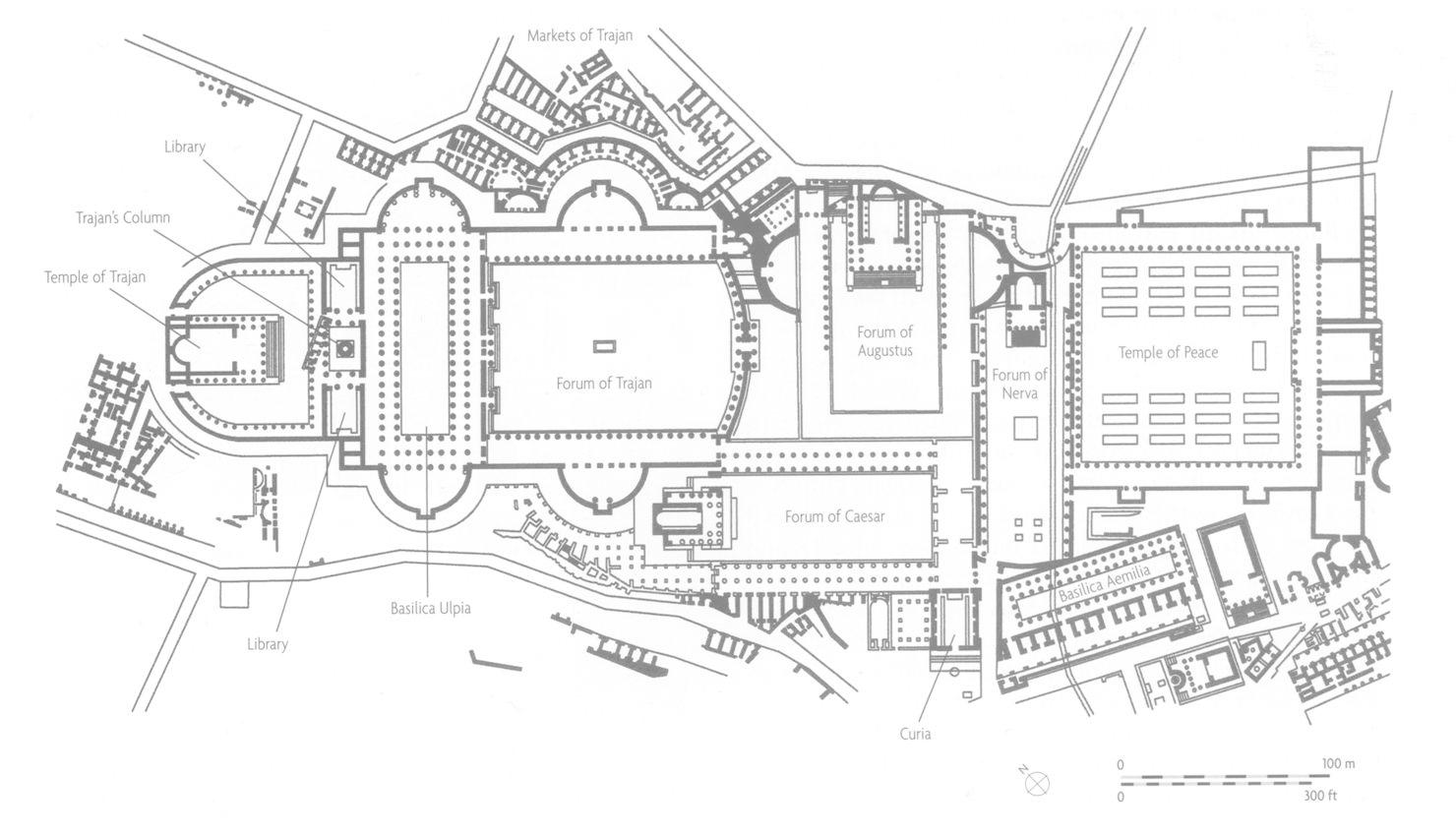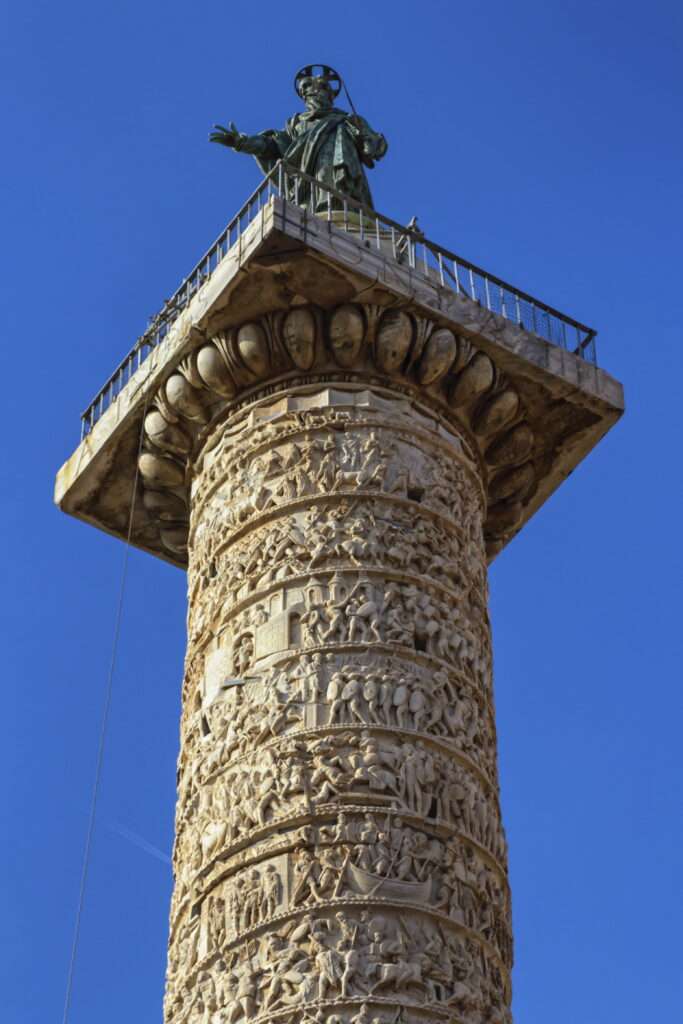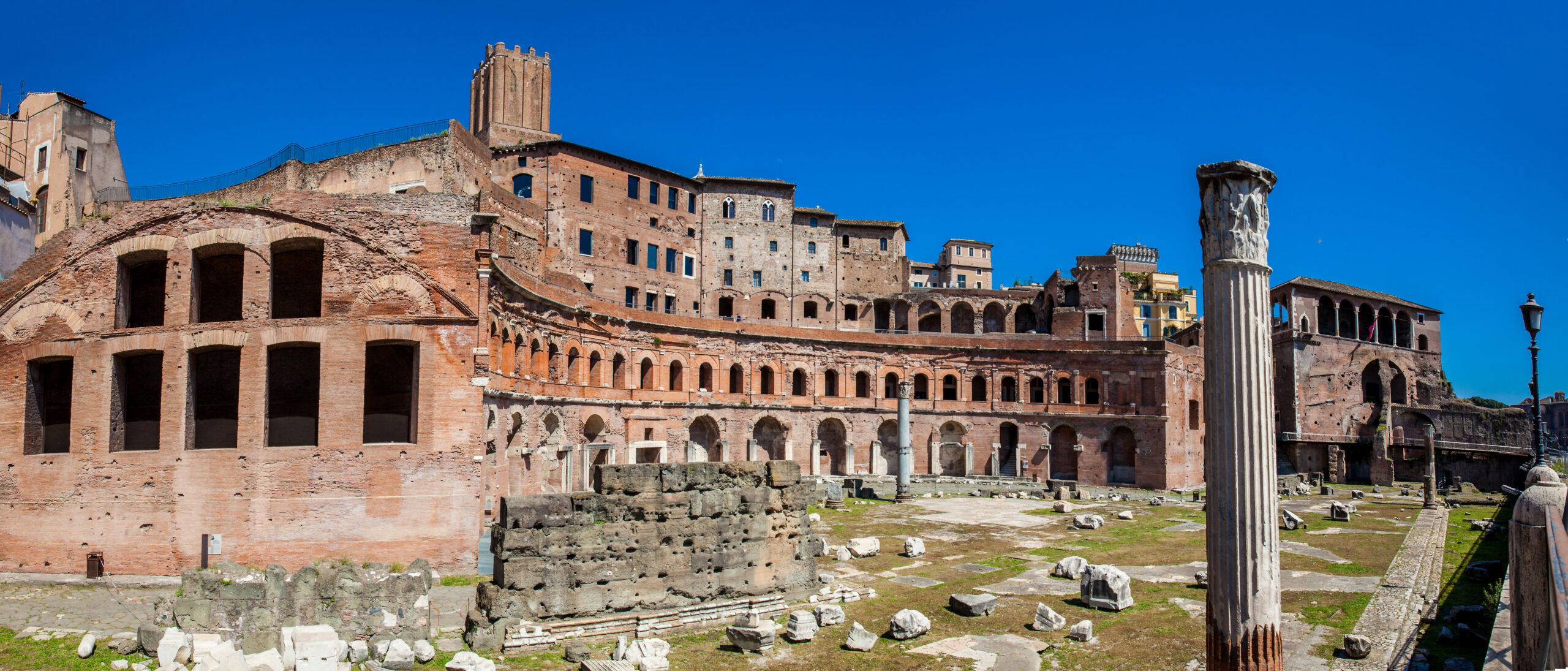The Forum of Trajan (Forum Traiani) or Trajan’s Forum was a vast complex of different buildings ordered to be constructed by Emperor Trajan sometime between AD 105 and 107.
It was located across from the Forum of Augustus. It measured approximately 280m (920ft) by 190m (620ft) and covered an area of 25 acres (10 ha). It was the last of the great forums built in Rome.
The Forum was designed by Apollodorus of Damascus. It was completed in AD 112, with the building of the Column of Trajan finishing a year later.
Owing to the lack of space in the area, a monumental amount of excavation and earthworks were undertaken to clear enough space to fit the entire complex. Workers had to remove a natural ridge that connected the Quirinal Hill and Capitoline Hill. Approximately 300,000 cubic meters were removed during the excavation process.
Due to its enormous size, it became the main space for the functions of government and politics, moving away from the Roman Forum.
The spoils from the Dacian wars funded the construction of the Forum, which was fought over two campaigns (AD 101-102 and AD 105-106). It contained an array of buildings and structures, including:
- The main forum square
- A large, bronze equestrian statue of Trajan
- Markets of Trajan
- Basilica Ulpia
- Libraries
- Trajan’s Column
- Temple of Trajan

By Samanthamalgieri – CC BY-SA 4.0
The Forum square
Entering the Forum, citizens were met with a giant bronze statue of Trajan on a horse. Most people congregate, socialize, and conduct business in this open area. We have some unique insight into the function and usage of the Forum via the ancient sources.
In Historia Augusta – The Life of Marcus Aurelius, XXI.VI, the emperor was gathering as many soldiers as possible for his Marcomannic Wars during a time when the Antonine Plague crippled the empire. The lack of manpower and money meant that the emperor had to resort to selling off imperial possessions:
“And since the pestilence was still raging at this time, he both zealously revived the worship of the gods and trained slaves for military service — just as had been done in the Punic war — whom he called Volunteers, after the example of the Volones. He armed gladiators also, calling them the Compliant, and turned even the bandits of Dalmatia and Dardania into soldiers. He armed the Diogmitae, besides, and even hired auxiliaries from among the Germans for service against Germans. And besides all this, he proceeded with all care to enroll legions for the Marcomannic and German war. And lest all this prove burdensome to the provinces, he held an auction of the palace furnishings in the Forum of the Deified Trajan, as we have related, and sold there, besides robes and goblets and golden flagons, even statues and paintings by great artists.”
While further in the Historia Augusta, we get a little insight into the reverence that the Forum is held in. The emperor chose the Forum as a place to erect statues of the noblemen who fell in his wars. XXII.VII:
“And because in this German, or Marcomannic, war, or rather I should say in this “War of Many Nations,” many nobles perished, for all of whom he erected statues in the Forum of Trajan.”
Passing through the main square, past the porticos on either side, visitors would find themselves at the entrance of the Basilica Ulpia.
Basilica Ulpia
The Basilica Ulpia was named after Trajan, whose full name is Marcus Ulpius Traianus. The Basilica was wedged between the Forum’s main square and the Temple and Column of Trajan. The basilica was a building that measured approximately 117m (385ft) by 55m (182ft). This basilica had no religious purpose and was generally used for civic purposes.
Libraries
Behind the Basilica are two libraries, one to each side, facing one another, with the Column of Trajan between them. One was a Greek library, and the other was a Latin library. The libraries kept civic paperwork, archives, edicts, and other laws handed down.
Trajan’s Column
Trajan’s Column is a masterpiece in itself. The column stands at 35m (115ft), including the large pedestal, with the column itself measuring approximately 30 meters (99ft). This height is significant as it equates to the approximate height of the earth cleared from the area so the Forum could be built. As Cassius Dio wrote in his Roman History, Book LXVIII, XVI.III:
“He also built libraries. And he set up in the Forum an enormous column to serve at once as a monument to himself and as a memorial of the work in the Forum. For that entire section had been hilly and he had cut it down for a distance equal to the height of the column, thus making the Forum level.”
The column comprised 20 marble drums and was originally adorned with a 4.8m (16ft) statue of the emperor himself. However, it was replaced with a statue of St. Peter in AD 1588. The hollow marble drums allowed a spiral staircase to be built inside. This staircase enables people to enter via the pedestal and venture up to the viewing platform, just under the statue of St. Peter. The design of the column also allowed for small windows, which are scattered along the way up, enabling those inside to get multiple perspectives of the rest of the Forum around it.
However, what is wrapped around the column really brings the column to life. The column is wrapped in an almost 200m long relief that depicts Trajan and his victory over the Dacians. Initially painted in vivid colors, the reliefs contain over 2,500 figures and take the viewer on a journey, visually explaining the main components of the wars and how Emperor Trajan won a substantial victory for the Empire.
It is said that Emperor Trajan’s ashes were interred in the base of the column.

Trajan’s Market
Just to the side of the main Forum square lays Trajan’s Market. This building was built up against the side of the Quirinal Hill.
It is approximately 150 meters long, stood about 35 meters high, and was constructed at the same time as the rest of the Forum. Preserved are around 150 shops & offices.
The prevailing theory for the use of the market was that it was a structure purely for small market stalls to sell their wares. However, another theory is that it was purely used as an administrative center where civic duties were carried out.
The market was built upon during the Middle Ages, with a defensive tower added at the turn of the fourteenth century. A convent and military barracks were also built on the site but were later torn down to preserve the ancient structure.
The Market complex is remarkably well preserved, with most of the building’s shell or “bones” still largely intact.

Temple of Trajan
Little is known about the Temple of Trajan. Still, it looks to have been built by Trajan’s successor, Emperor Hadrian, sometime between AD 121 and 138.
Historia Augusta – The Life of Hadrian, XIX.IX notes that when Hadrian returned to Rome after one of his tours, he set about commissioning the construction of many buildings, including the temple.
“He built public buildings in all places and without number, but he inscribed his own name on none of them except the temple of his father Trajan.”
We know that it was still in existence in the late fourth and early fifth centuries as it is listed in the fourth and fifth-century administrative document, The Regionaries, which lists all of the important buildings in Rome.
Bronze equestrian statue of Trajan
Little is known of this either, except it would not have lasted long during the sackings of Rome due to the valuable materials used. We know that it was still around during the middle of the fourth century, as Emperor Constantius II visited the Forum, among many other places, when he came to Rome.
In his book, Roman Antiquities, Ammianus Marcellinus notes in Book XVI, X.XV, that Constantius was in awe of the majesty of the Forum and the statue of Trajan:
“But when he came to the Forum of Trajan, a construction unique under the heavens, as we believe, and admirable even in the unanimous opinion of the gods, he stood fast in amazement, turning his attention to the gigantic complex about him, beggaring description and never again to be imitated by mortal men. Therefore, abandoning all hope of attempting anything like it, he said that he would and could copy Trajan’s steed alone, which stands in the center of the vestibule, carrying the emperor himself.”
The ensuing centuries saw people of the city quarry the marble and other building materials, stripping away the grandeur of this once stunning piece of architecture. The area was used in the Middle Ages for rural purposes as parts of the original Forum were buried under meters of earth. The column and market remain in good condition. However, the porticos of the Forum Square, the Basilica Ulpia, the libraries, and the temple have all disappeared, apart from a few columns that formed the basilica and bits and pieces.
Efforts have now been made to stand the marble columns upright again and combine them with modern materials. This is so visitors can distinguish between modern materials and the ones used by the Romans and to show off what these structures may have looked like when they stood during the days of the ancient civilization.
We can see the latest efforts in the Trajan’s Forum in this video by Darius Arya for the YouTube channel, Ancient Rome Live. It encapsulates what restoration work is taking place, not just in the Forum, but other places, such as the Theater of Marcellus.
Sources:
Roman History – Cassius Dio (Thayer)
The Life of Hadrian – Historia Augusta (Thayer)
Roman Antiquities – Ammianus Marcellinus (Thayer)
The Life of Marcus Aurelius – Historia Augusta (Thayer)
The Regionaries – Anonymous (Thayer)

